Dogs
Dog Agility
|
From Wikipedia the free encyclopedia, by MultiMedia
|
Back | Home | Up | Next |
Dog agility is a sport in which a handler directs a
Dog through
an obstacle course in an accurate race against the clock. Dogs must run
off-leash
with no food or toys as incentives. Consequently, the handler's only
controls are voice and
body language, requiring exceptional
obedience training of the animal. In competition, the handler must
assess the course, decide on handling strategies and direct the Dog
through the course, with precision and speed equally important.
In its simplest form, an agility
course consists
of a set of standard obstacles, laid out by an agility
judge in a
design of his own choosing on a roughly 100 by 100 foot (30 by 30 m) area, with
numbers indicating the order in which the Dog must complete the obstacles.
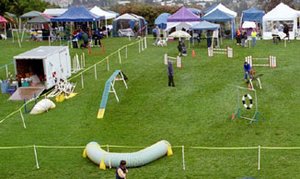 Agility field left side: A competition agility field showing (clockwise
from lower left) a tunnel, the Dogwalk, the judge standing in front of a winged
jump, two additional winged jumps, Dog executing the teeter-totter with his
handler guiding, and the tire jump.
Agility field left side: A competition agility field showing (clockwise
from lower left) a tunnel, the Dogwalk, the judge standing in front of a winged
jump, two additional winged jumps, Dog executing the teeter-totter with his
handler guiding, and the tire jump.
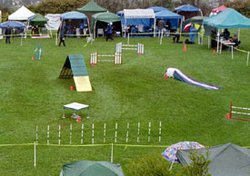 Agility field right side: The right side of the same agility field
showing (clockwise from foreground) the weave poles, the pause table, the
A-frame, two winged jumps, the collapsed tunnel (or chute), and a wingless jump.
Numbered orange plastic cones next to obstacles indicate the order in which the
Dog must perform them.
Agility field right side: The right side of the same agility field
showing (clockwise from foreground) the weave poles, the pause table, the
A-frame, two winged jumps, the collapsed tunnel (or chute), and a wingless jump.
Numbered orange plastic cones next to obstacles indicate the order in which the
Dog must perform them.
Competition basics
Because each course is different, handlers are allowed a short
walk-through before the competition starts. During this time, all handlers
competing in a particular class can walk or run around the course without their
Dogs, determining how they can best position themselves and guide their Dogs to
get the most accurate and rapid path around the numbered obstacles.
The walk-through is critical for success because the course's path takes
various turns, even
U-turns or 270 degree turns, can cross back and on itself, can use the same
obstacle more than once, can have two obstacles so close to each other that the
Dog and handler must be able to clearly discriminate which to take, and
can be arranged so that the handler must work with obstacles between himself and
the Dog, called layering, or at a great distance from the Dog.
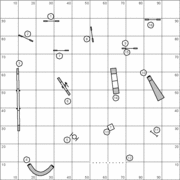 Course map showing the layout of the course in the preceding photos. Maps like
this are commonly used by handlers to help design their strategies. This is a
fairly simple, flowing course, probably used for novice Dogs.
Course map showing the layout of the course in the preceding photos. Maps like
this are commonly used by handlers to help design their strategies. This is a
fairly simple, flowing course, probably used for novice Dogs.
Handlers often use printed copies of the course map to help plan their
course strategy. There is standard format used course maps, with obstacles
having standard icons, measurements and grid having fairly standard dimensions
(in the U.S., the grid is drawn in ten-foot squares), and numbers indicating the
order in which the obstacles are to be taken.
Each Dog and handler team gets one opportunity together to attempt to
complete the course successfully. The Dog begins behind a
starting line and, when instructed by his handler, proceeds around the
course. The handler typically runs near the Dog, directing the Dog with spoken
commands and with the position of arms, shoulders, and feet.
Because speed counts as much as accuracy, especially at higher levels of
competition, this all takes place at a full-out run on the Dog's part and, in
places, on the handler's part as well.
When all competitors have run, scoring is based on how many faults are
incurred. In addition to course faults, such as knocking down a bar in a jump,
time faults which are the number of seconds over the calculated standard
course time, which in turn is determined based on the competition level, the
complexity of the course, and other factors.
Agility obstacles
Although different organizations specify somewhat different rules for the
construction of obstacles, the basic form of some obstacles is the same wherever
they are used. Obstacles include the following (note that dimensions vary by
organization, so consult the regulations for each organization before purchasing
or building equipment):
Contact obstacles
- A-frame
- Two platforms, usually about 3 feet (1 m) wide by 8 to 9 feet (3 m)
long, hinged together and raised so that the hinged connection is between
five and six-and-a-quarter feet above the ground (depending on the
organization), forming roughly an A shape. The bottom 36 to 42 inches (1 m)
of both sides of the A-frame are painted a bright color, usually yellow,
forming the contact zone, onto which the Dog must place at least one
paw while ascending and descending. Most sanctioning organizations require
that A-frames have low profile, narrow, horizontal slats all along their
length to assist the Dog's grip going up and down.
- Dogwalk
- Three 8 to 12 ft (3 to 4 m) planks, 9 to 12 inches (25 to 30 cm) wide,
connected at the ends. The center plank is raised to about 4 feet (1.2 m)
above the ground, so that the two end planks form ramps leading up to and
down from the center plank. This obstacle also has contact zones. Most
sanctioning organizations also require slats on the Dogwalk ramps; a
slatless Dogwalk looks almost the same as a teeter-totter to a Dog
approaching it head-on.
-
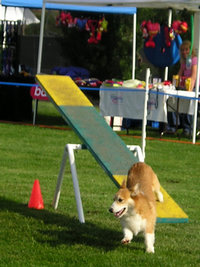 Teeter-totter - Dogs, such as this
Welsh
Corgi, must be in control as it hits the ground but then continue
running.
Teeter-totter - Dogs, such as this
Welsh
Corgi, must be in control as it hits the ground but then continue
running.
- Teeter-totter (or
seesaw)
- A 10 to 12 foot (3 to 4 m) plank pivoting on a support, much like a
child's seesaw. It is constructed slightly off-balance so that the same end
always returns to the ground. This is done either by placing the support
slightly off-centre or else weighting one end of the board. This obstacle
also has contact zones. The balance point and the weight of the plank must
be such that even a tiny Dog, such as a
Papillon or
Chihuahua, can cause the high end of the teeter-totter to descend to the
ground within a reasonable amount of time, specified by the sanctioning
organization's rules (usually about 2 seconds). Smaller Dogs get more time
to run a course, and this is one reason why it can take them longer than it
takes larger Dogs.
- Crossover
- Picture a 4 foot (1.2 m) high table (see "Miscellaneous") obstacle with
Dogwalk ramps descending from the center of all four sides. The Dog must
ascend the correct ramp and then possibly change direction at the top to
descend the ramp indicated by the handler. This has not been a commonly used
obstacle, mostly because of its size, and not all organizations have allowed
it.
-
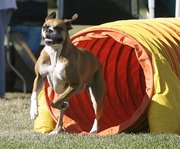 Tunnel - This
Boxer
demonstrates how most Dogs run full speed through a tunnel, often using the
back of a curved tunnel rather than trying to remain vertical.
Tunnel - This
Boxer
demonstrates how most Dogs run full speed through a tunnel, often using the
back of a curved tunnel rather than trying to remain vertical.
Tunnels
- Tunnel
(or chute)
- A vinyl tube, 10 to 20 feet (3 to 6 m) long and about 2 feet (60 cm) in
diameter, through which the Dog runs. The tunnel is constructed of flexible
vinyl and wire so that it can be configured in a straight line or curved.
- Collapsed tunnel (also called chute)
- A barrel-like cylinder with a tube of fabric attached around one end.
The fabric extends about 8 to 12 feet (3 to 4 m) and lies closed until the
Dog runs into the open end of the chute and pushes his way out through the
fabric tube.
- Tunnel maze
- A new obstacle (as of 2004) consisting of several interconnected tunnels
through which the handler must guide the Dog by voice commands. In the
United States, only CPE currently allows this obstacle, and it must be an
optional obstacle when used.
-
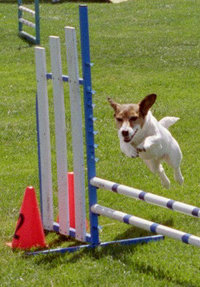 Winged single jump - Jump heights, and often course times, are
adjusted so that small Dogs such as
Jack Russell Terriers compete against similar-sized Dogs.
Winged single jump - Jump heights, and often course times, are
adjusted so that small Dogs such as
Jack Russell Terriers compete against similar-sized Dogs.
Jumps
- Jump (or hurdle)
- Two upright bars supporting a horizontal bar over which the Dog jumps.
The height is adjusted for Dogs of different heights. The uprights can be
simple bars or can have wings of various shapes, sizes, and colors.
- Double and triple jumps
- Two or three sets of uprights, each with horizontal poles. The Double
can have parallel or ascending horizontal bars; the triple always has
ascending bars. The spread between the horizontal bars is sometimes adjusted
based on the height of the Dog.
- Panel jump
- Instead of horizontal bars, the jump is a solid panel from the ground up
to the jump height, constructed of several short panels that can be removed
to adjust the height for different Dog heights.
- Broad jump
- A set of four or five slightly raised platforms that form a broad area
over which the Dog must jump without setting their feet on any of the
platforms. Length is adjusted for Dog's height.
- Tire jump
- This is just what it sounds like: A
tire shape
suspended in a frame. The Dog must jump through the opening of the tire,
which varies between about 18 and 24 inches (450 to 600 mm). The tire is
usually wrapped with tape so that there are no openings or uneven places in
which the Dog could catch. The height is adjusted for Dogs of different
sizes.
Miscellaneous
- Table (or pause table)
- An elevated square platform about 3-foot-by-3-foot (1-meter-by-1-meter)
square onto which the Dog must jump and pause, either sitting or in a down
position, for a designated period of time which is counted out by the judge,
usually about 5 seconds. The height ranges from about 8 to 30 inches (20 to
75 cm) depending on the Dog's height and sponsoring organisation.
- Pause box
- A variation on the pause table. The pause box is a square marked off on
the ground, usually with plastic pipe or construction tape, where the Dog
must perform the "pause" behavior (in either a sit or a down) just as he
would on the elevated table.
-
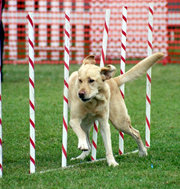 Labrador Retriever demonstrates fast weave poles.
Labrador Retriever demonstrates fast weave poles.
- Weave poles
- Similar to a
slalom,
this is a series of upright poles, each about 3 feet (1 m) tall and spaced
about 20 inches (50 cm) apart, through which the Dog weaves. It is one of
the most difficult obstacles for a Dog to master. It varies from 5 to 12
poles at one time. The Dog must always enter with the first pole to his left
and must not skip poles.
Agility scoring and clean runs
Each organization has its own rules about what constitutes faults and whether
one can earn a qualifying score with faulted runs. A completed run that
passes the minimum defined standards for time, faults, points, or so on, is
referred to as a qualifying run and in some cases earns credit towards
agility titles. A qualifying run is also referred to as a leg. A clean
run is one with no faults.
Different organizations place different values on faults, which can include
the following:
| Time faults |
Going over the maximum time alloted by the judge to complete a
course (the standard course time (SCT)). |
| Missed contact |
When the Dog fails to place a foot in the contact zone while
performing a contact obstacle. In popular jargon, a flyoff is
when the Dog misses the descending contact zone because he leaps from
the obstacle a long way above the zone, often in a spectacular flying
manner. |
| Knocked or dropped bar |
Displacing a bar (or panel) when going over a jump. |
| Weave pole fault |
The Dog must enter with the first pole to his left and proceed
through the weaves without skipping any. Entering incorrectly, skipping
poles, or backweaving when attempting to correct missed poles can all be
faulted. |
| Off course |
Dog takes the wrong obstacle on a course in which the obstacles are
numbered sequentially. |
| Refusal |
The Dog makes an approach towards the correct obstacle, but then
turns away or hesitates significantly before attempting the obstacle. |
| Runout |
The Dog does not directly approach the next obstacle, instead
running past it. |
| Other faults |
Can include Dog biting the judge or the handler or other
unsportsmanlike behavior, the handler exhibiting unsportsmanlike
behavior, the Dog eliminating in the ring, the Dog leaving the ring and
not coming back, the handler carrying toys or food into the ring, the
Dog running with his collar on (collars are prohibited in some
organizations), and others. |
Agility classes
Given the available set of obstacles and possible faults, there are many
permutations of games, or classes, that one can play on the agility
field. A typical course is laid out within a 100 by 100 foot (30 by 30 m) area,
with roughly 10 to 20 feet (3 to 6 m) between obstacles.
Judges design their own courses (with the exception of NADAC where judge's
pick their courses from a book) using the rules of the sanctioning organization.
Each organization decides which classes are valid for achieving titles and how
each must be performed, but there are many similarities.
Some of the common classes are
- Standard or Regular: This is a numbered course consisting
of (usually) at least one of each of the three contact obstacles plus jumps,
tunnels, and weave poles of various flavors. A novice course might consist
of as few as 15 obstacles; a higher-level course might have 22. The Dog must
negotiate the obstacles in the correct order within the standard course time
(SCT).
- Jumpers: This numbered course consists primarily of various types
of jumps and, depending on the organization, also weave poles and tunnels.
The Dog must negotiate the obstacles in the correct order within the
standard course time (SCT). The Dogs achieve their fastest speed on these
courses because there are no contact obstacles to slow them down.
- Gamblers , Jackpot or Joker: An unnumbered course.
The game typically consists of two parts, an opening period and the closing
period, also known as the gamble, joker, or jackpot. In the opening period,
the Dog has a certain amount of time in which to do whatever obstacles the
handler deems appropriate and accrues points based on the obstacles
completed. At the end of the allocated time for the opening period, a
whistle blows. At that point, the gamble begins. The Dog has a certain small
amount of time (about 15 seconds) in which to complete a sequence of
obstacles designated by the judge ahead of time. The challenge is that there
is a line on the ground past which the handler must not step, typically
parallelling the gamble obstacles, from 10 to 20 feet (3 to 6 m) away
depending on the level of competition. The handler must choose an opening
sequence that flows comfortably for the individual Dog's skills and
experience. The sequence must also be planned so that, when the whistle
blows, the Dog is in a good position to immediately begin the gamble. The
greatest challenge is the distance handling--getting the Dog to move
or even turn away from you.
- Snooker: Loosely based on the pool game of
Snooker.
The course has at least three red jumps, each numbered 1, and six
other obstacles numbered 2 through 7. The Dog accumulates points based on
the obstacle's number. This also has two parts, an opening sequence and a
closing sequence. In the opening sequence, the Dog must complete a 1, then
any obstacle numbered 2 to 7, a different 1 and any 2 to 7 obstacle
(including the one already performed), and yet another different 1 and
another 2-7 obstacle. For example, the Dog could perform the red on the left
for 1 point, the 7-point obstacle, the red in the middle for 1 point and
then the 7-pointer again, then the red on the far side of the course and the
7-pointer one more time, for a total of 24 points in the opening. After
successfully completing this, the Dog must complete the obstacles 2-7, in
order, for an additional possible 27 points. Failure to follow these rules
exactly (such as knocking a bar or taking 2 reds in a row) results in
the Dog and handler being whistled off the course.
- Strategy and entertainment value: The Dogs might have to
negotiate between other obstacles without taking them or make a
difficult entry to the obstacle, often combined with a longer distance
between the reds and the 7 so that it consumes more time to do the
higher-point obstacle in the opening.
Fairness among Dogs
Although each organization has its own rules, all divide Dogs into smaller
groups that are close to each other in size and experience for purposes of
calculating winners. This means that there will be winners in each group for
each class (or game) over the course of a trial.
Dogs are measured in height at the peak of their
withers
(shoulders). They are then divided into height groups; for example, Dogs
measuring between 12 and 16 inches (30 and 37.5 cm) might compete together with
the jumps set at a height of 16 inches (37.5 cm). This ensures that Dogs who
might have an advantage on a particular course because of their size (larger or
smaller) keep the advantage to a minimum.
Dogs are further divided into their experience levels. So, for example, you
might have the 12 inch (30 cm) Novice Dogs competing, the 12 inch (30 cm)
Intermediate Dogs competing, and the 12 inch (30 cm) Masters Dogs competing.
Dogs typically have to have certain numbers of successes at lower levels before
they can move up to compete with more advanced Dogs.
Some organizations even further divide Dogs into special categories because
the Dogs are older (usually over 7 years) or have junior handlers (usually under
18) or the like.
History of Dog agility
Dog agility is a fairly new sport, created as merely a demonstration in the
late 1970s in the
United Kingdom. It has since spread rapidly around the world, with major
competitions held worldwide.
Its first widely-documented appearance was as entertainment at the
Crufts
Dog show in
1978. John Varley, a committee member from the 1977 show, was tasked with coming
up with entertainment for the audience between the obedience and conformation
competitions in the main ring. Varley asked Dog trainer Peter Meanwell for
assistance, and they presented a largely jumping-style course resembling
something from the equestrian world to demonstrate Dogs' natural speed and
agility. It was reported in
Our Dogs newspaper in 1974 that Meanwell had either been a witness to or
participated in such a competition at an agricultural fair, thus pre-dating more
widely published accounts for the start of Dog agility. (By some oral accounts,
there was an earlier demo with similar intent using playground articles such as
a
teeter-totter and a
tunnel,
although this has not been documented. Another account attributes the other
obstacles to exhibitions by the Royal Air Force K-9 Corps exhibitions of the
time, which is more plausible, given the nature of the first regulations for Dog
agility in the UK.)
At the 1978 Crufts, the demonstration immediately intrigued Dog owners
because of its speed and challenge and the dexterity displayed by the Dogs.
People wanted to see more, and indeed wanted their own Dogs to be able to
participate. The demonstration was so popular that it grew into local, then
national, and eventually international, competitions with standardized
equipment. In 1980,
The Kennel Club became the first organization to recognize agility as an
official sport with a sanctioned set of rules. By this time, agility equipment
included some additional elements modified from the training of police Dogs and
Schutzhund
competitions, such as the A-frame and the Dogwalk.
History in the United States
In the
United States, several people experimented with Dog agility based generally
on the KC rules. The first exhibitions took place in the early 1980s.
USDAA's influence
In 1985,
Kenneth Tatsch collaborated with his local obedience club and others, and
began putting on exhibitions in Texas. A year later he founded the United States
Dog Agility Association (USDAA)
and incorporated in January 1987 in Texas. To promote the sport, USDAA secured
Pedigree Dog Food (formerly Kal Kan Dog Food, a sister company to Chum Dog
Food, the guiding sponsor in the UK) as a sponsor, and the first national
championship tournament series in North America—the Grand Prix of Dog
Agility—was introduced in 1988 at the Astro World Series of Dog Shows in
Houston, Texas.
Until 1990, USDAA agility competitions were only for placement ribbons, but
at that time the USDAA began offering agility titles, for which the Dog had to
perform to certain standards in several competitions to earn scores towards the
various titles. At first, the only titles offered were the Agility Dog (AD), or
starters-level title; the AAD Advanced Agility Dog (AAD), or intermediate-level
title, and the Master Agility Dog (MAD), or expert-level title. This increased
the appeal for all Dog owners; one's Dog did not have to be a
superstar
to succeed at agility, but could simply be good enough and fast enough to meet
the requirements to earn title points. USDAA's vision was far broader than a
single class, and in 1994, USDAA introduced an expansive titling program to
incorporate title recognition in each of four nonstandard classes (those other
than the basic form)—gamblers choice, jumping, snooker agility, and relay.
In 1988, almost no one had heard of Dog agility in the United States, while
meanwhile in England it had become an extremely popular sport, drawing hundreds
of spectators. By 1989, however, when the USDAA Grand Prix of Dog Agility was
first filmed for TV, nearly 2000 spectators attended the final round. Just a
year later, attendance neared 4000. The event's popularity sparked interest
around the country, and in 1989, Tatsch expanded the tournament to include local
qualifying events, hosted by groups formed by competitors in attendance at the
Grand Prix the prior year in Texas. The tournament grew rapidly, jumping
from 8 events in 1989 to more than 150 local and regional championship events in
2004, in five countries, leading to a World Championship event. Tatsch also
named his first Advisory Board composed of experienced trainers and agility
enthusiasts from different parts of the country, who began working on a set of
regulations for titling programs that were adopted in May 1990.
Meanwhile, the agility equipment used by the USDAA mirrored its British
counterparts, as did the basic rules for the standard agility course. USDAA also
introduced Jumpers Classes and other nonstandard classes from Great Britain,
such as Gamblers and Snooker, which encourage handlers to design their own
courses under strict sets of rules established by the judge on the day of
competition, and the Relay, which pairs up two Dogs and two handlers to take on
a course resembling the standard agility course.
AKC
The
AKC, which for decades had sanctioned
Dog shows,
obedience trials, and other
Dog sports
joined the agility world. In 1987, Charles (Bud) Kramer founded the National
Club for Dog Agility (NCDA) in
Manhattan, Kansas with the goal of convincing the AKC to recognize agility
as a sport. When the AKC entered the field each competition had only one
standard course. The first AKC event to include a sanctioned agility match was
held in August at the St. Croix Valley Kennel Club Show in
Lake Elmo, Minnesota. Sanctioning by the AKC made the rapidly growing sport
nearly explode in the United States, as AKC handlers began exploring USDAA and
NADAC competitions as ways to expand their agility experience. A few years
later, AKC introduced its own version of the Jumpers course, which included
weave poles as did the International rules but which NADAC and USDAA did not
include.
Additional organizations
Bob and Marliu Basin created the American Agility Associates in Colorado.
Neither of these organizations lasted much beyond the early 1990s. In 1993,
Sharon Nelson founded her own agility corporation, the North American Dog
Agility Council (NADAC),
using a slightly different set of rules and concepts. At that time, NADAC and
USDAA used the same equipment and had similar rules for the standard numbered
and jumpers courses; NADAC also included the Gamblers event in its rulebook.
The
United Kennel Club (UKC) introduced its own rules at about the same time;
UKC agility has evolved into a different kind of sport than that provided by AKC,
USDAA, and international agility organizations, involving more control of the
Dog over complicated obstacles rather than speed and accuracy over basic
obstacles.
When the
FCI introduced its international agility championships, it continued its
affiliation with purebred
kennel
clubs around the world, including the AKC, allowing the AKC to choose a team
from among its registered competitors. As a result, many top-level American Dogs
without AKC registration were shut out of international competition. To
compensate, two additional organizations--the International Agility Link
(organized through email) and the World Dog Show--sponsored international
competitions starting around 1996 that allowed any competing Dogs to be part of
their country's teams; the World Dog Show affiliated with the USDAA, while the
IAL remained independent. The World Dog Show hosted a couple of international
championships but financially could not continue, so the USDAA began pursuing
its own affiliations with other organizations and clubs worldwide to start its
own International Championships. In 2001, the Grand Prix of Dog Agility®,
previously national in scope reached beyond North American boundaries and became
a truly international event, hosting teams from several countries on other
contients..
Meanwhile, in the early 1990s, the
Australian Shepherd Club of America (ASCA) decided to provide its own
sanctioning rules for agility in lockstep with NADAC, so that one could earn
either ASCA or NADAC titles, or both, at dual-sanctioned events. However, over
time, NADAC has moved away from the International standards, focusing on its own
vision of a faster but less physically stressful environment. It has gradually
eliminated or changed many of the obstacles so that its equipment specifications
and many of its rules no longer match those of the USDAA, AKC, or FCI. As of May
31st, 2006, ASCA and NADAC will no longer be dual sanctioning trials as the ASCA
agility program returns to an earlier set of rules that more closely match those
of the rest of the agility community.
In 1995, Canine Performance Events (CPE) was founded by Linda Eikholt, who
preferred an environment that was less intense and with less rigorous
requirements than those preferred by the USDAA, yet retained the variety of
events and the invitation for able-bodied Dogs of any ancestry to compete. CPE
agility continues to grow in the United States.
Continuing changes
The sport of agility continues to grow and change. Every year brings the
addition of new clubs and new classes. The rules for each organization go
through periodic review as well, requiring that competitors in each organization
keep up with the current rules, regulations, and class offerings.
Agility in the United States
The first agility competition in the
United States took place around 1986 under the rules of the newly-formed
United States Dog Agility Association (USDAA).
The following organizations have rules for agility performance, titles, and
equipment in the United States. These organizations sanction clubs to allow them
to host agility competitions ("trials" or "matches").
-
American Kennel Club (AKC). External link:
[1]
-
United States Dog Agility Association (USDAA). External link:
[2]
-
North American Dog Agility Council (NADAC). External link:
[3]
-
Canine Performance Events (CPE). External link:
[4]
-
United Kennel Club (UKC). External link:
[5]
-
Australian Shepherd Club of America (ASCA). External link:
[6]
-
Teacup Dogs Agility Association (TDAA). External link:[7]
Agility in Canada
See the following website for information about Agility in Canada:
-
Agility Association of Canada (AAC). External link:
[8]
Agility titles and championships
For most sanctioning organizations, there are a variety of titles that a Dog
and handler can earn by accruing sufficient qualifying runs--also called legs--that
is, runs that have no more than a certain number of faults (typically none) and
are faster than the maximum standard course time (SCT).
For example, under USDAA rules, a Dog can earn novice-level titles in
Standard, Jumpers, Gamblers, Snooker, and Pairs Relay classes by earning 3
qualifying runs in each of the classes; the Dog can also earn intermediate-level
titles and masters-level titles in the same classes. After earning all of the
masters-level titles--five qualifying runs in each, with some that must be in
the top 15% of Dogs competing at each trial--the Dog earns its Championship.
Other organizations have similar schemes; in AKC, to earn the Championship, the
Dog's qualifying runs must be earned two at a time on the same day; in NADAC,
the quantity of qualifying runs is much larger; and so on. Most champion titles
have "CH" in the title: NATCH (NADAC Agility Trial Champion), ADCH (Agility Dog
Champion for USDAA), CATCH (CPE Agility Trial Champion), MACH (Master Agility
Champion for AKC), TACH (Teacup Agility Champion), ATCH (ASCA Agility Trial
Champion) and so on.
National championships
In addition, each sanctioning organization holds its National
championships each year. Dogs must meet certain minimum scoring requirements
to qualify to compete in the annual championship; for example, must earn
qualifying scores in at least 50% of the runs at each of at least 3 trials
during the year; or must place in the top certain percentage of Dogs at certain
trials; or must have a qualifying run in special regional qualifying events; and
so on.
Just as with any agility competition, there will be national champions at
each height category because it is not really possible for Dogs of greatly
different sizes to compete equally. For example, USDAA has 12", 16", 22", and
26" (30, 40, 55, and 66 cm) jump height categories; it crowns 4 national Grand
Prix champions each year, as well as four Veterans and four Performance
(lower-level performance) Grand Prix champions. It also holds championships for
its Dog Agility Steeplechase® and its Dog Agility Masters® Three-Dog Team
tournament series.
International championships
Some competitions invite qualified entrants from multiple countries, thereby
making them International Championships. Examples:
-
FCI, the oldest and best-known, usually held in Europe
- The International Federation of Cynological Sports (IFCS), since 2002
has organized a biannual international agility world championship
competition open to any breed or
mixed-breed Dog regardless of pedigree. The United States, via the
United States Dog Agility Association (USDAA), is an associate member
along with, as of 2005, more than twenty participating countries.
Training
Teaching a Dog the basic execution of most obstacles takes only a small
amount of time and simple training techniques; most Dogs can be readily
convinced to run through a short, straight tunnel to chase a toy or to go to
their owner, for example. However, to compete in agility trials and to develop
speed and accuracy, both Dog and handler must learn a wide range of techniques
for doing the equipment, performing sequences of obstacles, and communicating on
course while running full out.
The teeter-totter and the weave poles are probably the most challenging
obstacles to teach, the first because many Dogs are wary of the board's
movement, and the second because it is not a behavior that they would do
naturally over a series of 12 poles. However, it can also be challenging to
train the Dog to perform its contact obstacles in a manner that ensures that
they get paws into the contact zone without sacrificing speed.
Training techniques vary greatly. For example, techniques for training the
weave poles include using offset poles that gradually move more in line with
each other; using poles that tilt outward from the base and gradually become
upright; using wires or gates around the poles forcing the Dog into the desired
path; putting a hand in the Dog's collar and guiding the Dog through while
leading with a toy or treat; teaching the Dog to run full speed between 2 poles
and gradually increasing the angle of approach and number of poles; and many
other techniques.
References
External links
In addition to the sanctioning organizations listed previously, general
information is available at the following:
Dog sport forums and email lists link the agility community and allow people
to learn more about agility and to communicate with other agility enthusiasts:
Home | Up | List of Dog Sports | List of Protection Sports | Badger-Baiting | Bait | Dog Fighting | Sled Dog | Greyhound Racing | Canicross | Carting | Companion Dog Title | Coursing | Dachshund Racing | Disc Dog | Dog Agility | Dog Harness | Dog Racing | Dog Scootering | Dog Show | Drag Hunting | Flyball | Lure Coursing | Mushing | Musical Canine Freestyle | Pulka | Schutzhund | SheepDog Trial | Skijoring | Tracking | Weight Pulling | Wiener Nationals
Dogs, made by MultiMedia | Free content and software
This guide is licensed under the GNU
Free Documentation License. It uses material from the Wikipedia.
collie breed working terrier hound spaniel baiting bullDog
 Agility field left side: A competition agility field showing (clockwise
from lower left) a tunnel, the Dogwalk, the judge standing in front of a winged
jump, two additional winged jumps, Dog executing the teeter-totter with his
handler guiding, and the tire jump.
Agility field left side: A competition agility field showing (clockwise
from lower left) a tunnel, the Dogwalk, the judge standing in front of a winged
jump, two additional winged jumps, Dog executing the teeter-totter with his
handler guiding, and the tire jump. Agility field right side: The right side of the same agility field
showing (clockwise from foreground) the weave poles, the pause table, the
A-frame, two winged jumps, the collapsed tunnel (or chute), and a wingless jump.
Numbered orange plastic cones next to obstacles indicate the order in which the
Dog must perform them.
Agility field right side: The right side of the same agility field
showing (clockwise from foreground) the weave poles, the pause table, the
A-frame, two winged jumps, the collapsed tunnel (or chute), and a wingless jump.
Numbered orange plastic cones next to obstacles indicate the order in which the
Dog must perform them. Course map showing the layout of the course in the preceding photos. Maps like
this are commonly used by handlers to help design their strategies. This is a
fairly simple, flowing course, probably used for novice Dogs.
Course map showing the layout of the course in the preceding photos. Maps like
this are commonly used by handlers to help design their strategies. This is a
fairly simple, flowing course, probably used for novice Dogs. Teeter-totter - Dogs, such as this
Welsh
Corgi, must be in control as it hits the ground but then continue
running.
Teeter-totter - Dogs, such as this
Welsh
Corgi, must be in control as it hits the ground but then continue
running. Tunnel - This
Boxer
demonstrates how most Dogs run full speed through a tunnel, often using the
back of a curved tunnel rather than trying to remain vertical.
Tunnel - This
Boxer
demonstrates how most Dogs run full speed through a tunnel, often using the
back of a curved tunnel rather than trying to remain vertical. Winged single jump - Jump heights, and often course times, are
adjusted so that small Dogs such as
Jack Russell Terriers compete against similar-sized Dogs.
Winged single jump - Jump heights, and often course times, are
adjusted so that small Dogs such as
Jack Russell Terriers compete against similar-sized Dogs. Labrador Retriever demonstrates fast weave poles.
Labrador Retriever demonstrates fast weave poles.